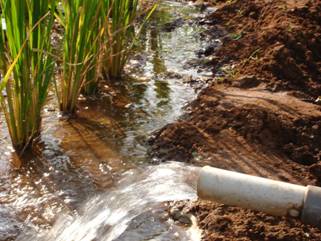Flood Irrigation

Flood irrigation is an ancient method of irrigating crops. It was likely the first form of irrigation used by humans as they began cultivating crops and is still one of the most commonly used methods of irrigation used today.
Very simply, water is delivered to the field by ditch, pipe, or or some other means and simply flows over the ground through the crop. Although flood irrigation is an effective method of irrigation it is certainly not efficient compared with other options. With flood irrigation it is generally assumed that only half of the water applied actually ends up irrigating the crop. The other half is lost to evaporation, runoff, infiltration of uncultivated areas, and transpiration through the leaves of weeds.
Although flood irrigation will never be as efficient as other types of irrigation there are several techniques that can be used to improve its efficiency:
- Leveling fields – because water is transported using gravity it won’t reach high spots in the field
- Surge flooding – rather than releasing water all at once it is released in intervals allowing each release to infiltrate the soil before releasing additional water.
- Recycling runoff – water that runs off the end and sides of the irrigated are is captured in low-lying areas and pumped to the top of the field where it can be reused.
It is common for flood irrigators to release water until the entire field is covered. By flooding the entire field all at once, irrigators fail to take advantage of capillary movement of water through the soil, particularly in clay soils. This results in significant runoff, anaerobic conditions in the soil and around the root zone, and deep irrigation below the root zone that is unavailable to the plants.
Soil moisture sensors provide irrigators with a useful tool when used in conjunction with surge irrigation (also known as cut-off irrigation). Strategic placement of sensors near the end of the irrigated area and at selected depths alert the irrigator when the soil is saturated and irrigation should be cut off to take advantage of the infiltration that occurs. This type of irrigation is similar to the ‘cycle and soak’ irrigation recommended for spray irrigation systems and provides similar benefits. |

